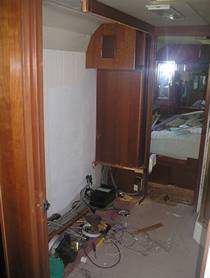The Great RV Makeover – Week 3
Well, we continue to make progress (whatever that means) on the new FM3. Merle (the Amish floor covering guy) came over and said it looks doable. He plans to lay the flooring on Oct. 12. Now all I have to do is have everything ready for him when he gets here.
Got the bunk beds roughed in and now all I have to do is make them “shine.” They aren’t exactly spacious, but I think they’ll work.



I was having a little trouble starting the rig, but after replacing one battery and a couple of big thick cables, it started right up. I think I have another battery to replace as well…which leads me to my next comment. I know nothing about diesel motors. If you are a diesel expert and wouldn’t mind being my go-to-guy for diesel questions, would you please contact me? I need a little help. I feel like I’m dealing with a new beast and don’t know much about it.
This weekend, besides having fun and taking our trash to the big trash day, I plan to work on getting the floor ready for Merle.
Until next time!




Diesels have pretty high compression ratios, even if they are turbocharged. They also have big, heavy parts. This all puts extra strain on the starting system. Both the positive battery cable and the ground cables must be in top condition, especially at the ends, or you will have trouble. Batteries must be fit too, as you have learned. The situation gets worse when the weather grows colder. Oil gets thicker, and the air doesn’t get hot enough at cranking speed to initiate the combustion process. This is where glow-plugs come in. They supply the heat needed to start the fire in each cylinder. Get a copy of the manual for you engine, and follow it. Especially work on changing your start-up routine. Diesel owners should allow time for things to warm-up before, and after starting the engine. A friend of mine says to use only Shell Rotella synthetic oil in a diesel. The oil has to do more piston cooling (it is sprayed against the underside of the piston) than with a gasoline engine, and it has to deal with more contamination from combustion processes. The sump probably holds more oil than your gas engine did, and the Rotella is expensive, but you get longer component life in the bargain. Don’t run much longer between oil changes than suggested by the manufacturer, but don’t change it quicker either.
Doug did a great job about the differences. There are shops that will test the oil as it is replaced to check for engine ware, find a good local diesel shop. I drive for Publix and that is how they know when to do certain service procedures on the engine.
Do give it extra time to warm up and cool down, don’t pull up to your destination and immediately shut it down, it’s really bad for the engine, on the other hand that thing will idle for long periods without damage. I live in Florida so we don’t take any cold weather precautions, maybe someone else will know about that.
Hey Todd,
Please let me know if you ever need help with your RV roof, graphics, or detailing. That’s what I do for a living. I know we aren’t exactly neighbors (I’m in Southern California), but I can certainly point you in the right direction for anything you need. Best of luck and God bless you and your family. ~~~ Jeff
accentstripes@aol.com
[…] we gutted the thing, recovered all the furniture, the floors and walls, added new light fixtures, removed the washer and dryer and a big closet and built in triple bunk beds and got the thing […]
How much space do you have between the bunks. I plan on using a 6″ foam mattress for the grandkids and would like to have 3 bunks stacked. Thanks for your help.
Hey Curtis,
Without measuring I’d bet we have about 24 inches. Not a lot…but on one of my son’s birthdays we spent the night on a ww 2 sub, They had bunks everywhere and some were less than 24 inches. I thought If grown men can sleep here…so can my kids. I like the idea of 6inch mattresses. We used foam..which breaks down (even the good stuff) I thought about cutting down a memory foam mattress…The beds aren’t very wide either in our bunks.
Good luck and let me know how it turns out.
Would like to know where you got the building plans for the bunk bed? Thanks!!!
Hey Jim,
Unfortunately I didn’t have any plans. I basically took two sheets of plywood…one on each end and attached three 2X4 frames to the end and then slid it in and attached the whole thing to walls. The weight of the beds and people is then on the plywood ends (like the head frame and foot board of a bed). The walls just don’t have enough support to take the weight of the beds or people. I hope that helps a little. Let me know if you have any other questions. The beds have held up great for 8-9 years.
Do you have a picture of the finished bunk beds with mattresses?